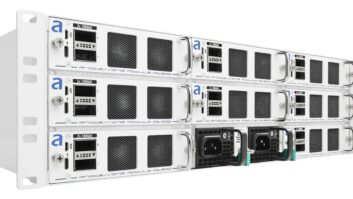
As co-founder of the company, Dan Castles has led Telestream throughout its 16-year history, seeing it grow from being a file-based workflow pioneer to become one of the leading influencers in enterprise-class video transcoding and workflow solutions. He reflects on the evolution of video over IP and provides an insight into the challenges facing broadcasters and facilities today.
As a starting point, it’s worth defining that video over IP is file-based media workflows controlled by software being processed on industry standard hardware platforms across standard IT infrastructures.
Some think that IP is the new kid on the block, but in fact it’s been around for some time. Over the course of the past 15 years or so, we’ve seen broadcast servers, NLEs, character generators and many other production tools migrate over to file-based, integrated IP technology. The transition of these pockets of innovation has resulted in individual parts of the overall workflow realising the benefits of file-based, or IT-based, systems.
Today, we are seeing whole new categories of devices, broadcast cameras for example, which integrate IP technologies and are moving over to file-based operation. This means that file-based workflows are starting right from the acquisition stage and moving all the way through post production to distribution.
This gives rise to an ecosystem that has grown to accommodate not only the video and audio but also the processing of, and reaction to metadata. Metadata is becoming much more important to our industry. It enables us to use all the facets of the media to automate the workflow processes and thereby increase efficiency and productivity. In essence we can now create smart workflows that build intelligence and decision-making into media processes.
In the past we have seen islands of IP-based operation but today we’re seeing them join together to create entire media ecosystems that are file/IP-based. This is a key enabler of the increased automation, intelligence and productivity that we can see in today’s multi-platform broadcast operations. Without doubt, we have far more sophistication in broadcast workflows, brought about by the increased usage of science in the analysis, management and extraction of value in media operations.
Evolution not revolution
The broadcast industry is different from many other technology-based markets. As an industry, we are excellent at assimilating new technologies and building business models around them to provide appealing customer propositions and to monetise our rich content legacy. But it does not happen overnight.
For some vendors, the rise of IP within their corporate strategies appears to have been quite sudden – some talk about a revolutionary change that will take the industry by storm within the next five years. For Telestream, it could not be more different. From our perspective, the transition is not starting: it’s been evolving for years.
Interoperability between vendors’ equipment has been a long-term requirement. The simple fact is that we live in a multi-vendor world where no single company has a comprehensive ‘cradle to grave’ file-based workflow solution. In an environment where technical and market demands are increasing, it is important for companies to collaborate to reduce complexity – providing workflow efficiencies with deep integration capabilities between different vendors’ systems.
Does DPP signpost a file-based future?
What this year’s IBC confirmed to me is that we’re at an intriguing stage in the development of IP-based media operations. It offers tremendous opportunities, and these will materialise at an increasingly rapid rate over the coming years. We have been supporting an evolutionary process for the last 16 years, and we are excited to be part of this process.
In the UK, we are witnessing a fascinating IP initiative in the form of the Digital Production Partnership (DPP). On one level this is just one regional project aimed at creating a level playing field in file-based operations. But on another it could provide a flexible blueprint for the adoption and promotion of file-based media operations worldwide. And that blueprint works on several levels – not just in terms of technical standards but also in illustrating what can be achieved when companies come together and pursue common goals.
DPP is just one initiative in one region but it is indicative of a growing global trend towards the increased integration of file-based workflows within media operations. We’re entering a critical phase in this evolutionary process – one that will need careful planning and implementation. While the implementation of IP has been happening for some time it is really just beginning to reach mass adoption.







